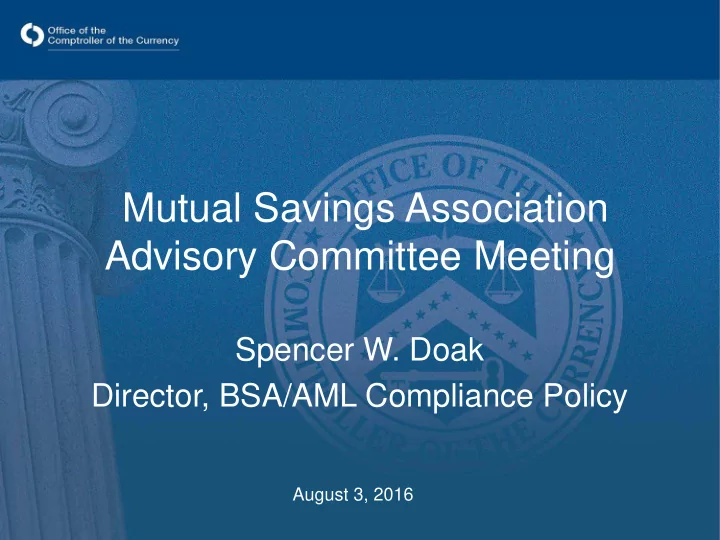

Mutual Savings Association Advisory Committee Meeting Spencer W. Doak Director, BSA/AML Compliance Policy August 3, 2016
BSA Requirements – Regulatory Updates Customer Due Diligence Requirement (May 2018) – FinCEN considers CDD as consisting of the following four elements: (1)identifying and verifying the identity of customers; (2) identifying and verifying the identity of beneficial owners of legal entity customers; (3) understanding the nature and purpose of customer relationships; and (4) conducting ongoing monitoring for reporting suspicious transactions, and, on a risk-basis, maintaining and updating customer information 2
BSA Requirements – Regulatory Updates Customer Identification Program (CIP) Requirements for bank issued prepaid cards − The FBAs and FinCEN issued Interagency Guidance to Issuing Banks on Applying CIP Requirements to Prepaid Cards (March 21, 2016). − The guidance clarifies that CIP requirements should apply to general purpose prepaid cards that provide a cardholder with (1) the ability to reload funds or (2) access to credit or overdraft features . − Existing supervisory expectations are that a bank, savings association, and a branch and agency of a foreign bank should apply its CIP to the cardholders of certain prepaid cards that it issues, including prepaid cards issued by the bank under arrangements with third-party program managers that sell, distribute, promote, or market the prepaid cards issued by the bank. − The application of CIP to prepaid cards with these features does not apply new requirements . The ability to reload funds is comparable to a deposit; and access to credit is comparable to a loan – both of which are defined as accounts under the BSA. 3
Financial Technology (Fintech) Technology is changing rapidly. Introduction of new technologies should consider: – Effective risk management aligned with the bank’s overall business strategy – Key individuals involved in the review and approval process when new products and services are introduced – Processes to review and approve existing products and services changes – Internal controls to monitor, manage, and mitigate risk – Policies, procedures, and processes – Training for appropriate staff 4
BSA/AML Compliance Program Expectations A comprehensive BSA/AML Compliance program commensurate with the BSA /AML risk of the institution. • Designation of a qualified BSA/AML Officer. – Sufficient authority – Provide sufficient number of staff with expertise and knowledge • Internal controls should include: – Implementation of a suspicious activity monitoring program and a system commensurate with the risk of the institution. – Establish client risk assessment methodologies that are reasonable and documented – Gathering and analysis of CDD/EDD information to identify customer risks 5
BSA/AML Compliance Program Expectations • Audit reviews that conclude on the BSA/AML compliance program and keep pace with the BSA/AML risk of the institution. – Conducted by qualified independent parties – Risk-based and evaluate the quality of risk management for all of the bank’s activities • Ongoing risk based training tailored to the individuals’ specific responsibilities. – Training is required for all bank personnel whose duties require knowledge of the BSA/AML, including the board of directors and senior management – Training must include regulatory and internal BSA/AML policies 6
BSA/AML Risk Assessment Expectations • Ongoing BSA/AML risk assessment processes to address the varying degrees of risk associated with products, services, customers, entities, and geographic locations. • Accordingly adjust BSA/AML risk assessment as new and emerging risks that affect BSA/AML present themselves. • Understanding of the bank’s risk appetite that defines both quantitative and qualitative parameters for safe and sound operating environments. 7
BSA Hot Topics • Risk Reevaluation – Banks must put appropriate controls in place to prudently manage their risks posed by their accounts. – Banks make their own evaluation of the risks associated with the particular products or services; and their own capacity to effectively monitor, manage and mitigate those risks. – Decision to exit a line of business or to terminate a banking relationship with a customer resides solely with the bank, not with the OCC. • Panama Papers – Leak from the Panamanian law firm, Mossack Fonseca – Papers revealed that more than 500 banks world wide, their subsidiaries and branches registered nearly 15,000 shell companies with Mossack Fonseca. – FinCEN has advised that 42 SARs have been filed by U.S. banks concerning Mossack Fonseca transactions. – A Federal review group led by the DOJ has been tasked with reviewing the voluminous data and determining what information can be used by the U.S. government, what data can be shared and what data may be privileged. 8
Takeaways • Banks operations and controls need to keep pace with institutions size, complexity, and risk profile. • Review and approval process for new products, services, and technologies. • Tone at the top and sound governance are critical to assure ongoing compliance. 9
Recommend
More recommend